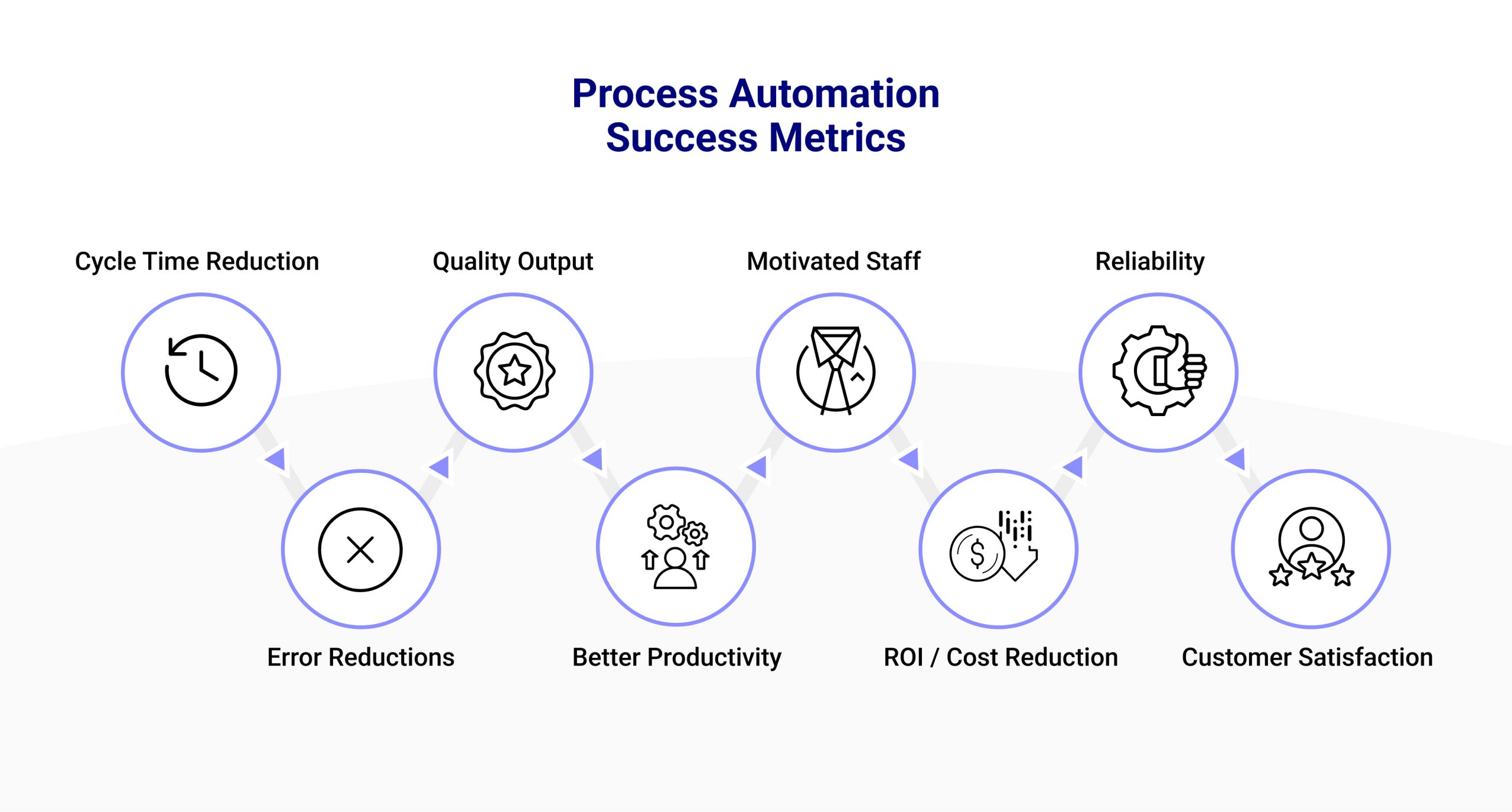Process Automation
BLOG
7 min read
Process Automation Success Metrics: What to Track and Why
Introduction
In today’s competitive world, it is essential to adapt to modern practices, attain better efficiency, deliver quality output, and enhance overall performance. That’s why automation has become the driving factor in the organizational operations.
While keeping pace with modern practices is one thing, we must also consider the benefits that the organization can derive by automating a process, as that’s how we can measure the success of the deployment.
Driving Factors for Automation (The Key KPI)
It is essential to have a clear understanding of goals and objectives before automating any process. There could be various driving factors that could contribute to the idea of automating a process. A few key factors could be a process being highly repetitive and monotonous for employees, cost effectiveness of the BOT, accuracy & efficiency that the BOT provides, etc. Thus, it is important to keep in mind the key driving factor/factors behind any automation.
Other Benefits
Bots are usually low-cost and easy to implement, providing organizational cost reduction and error reduction. Automating processes also allows employees to emphasize more on value-added tasks.
To experience fully optimized automation, it’s recommended to partner with a trusted service provider, like Accelirate, offering proven expertise in this realm. Explore Accelirate’s comprehensive process automation services for a smooth transition.
Key Practices to Measure the Success of Any Automation

Automation significantly impacts efficiency and performance. To gauge its success, organizations must adopt key practices aligned with their objectives. Let’s look at some of them.
01 - Set Appropriate Goals to Measure
It is essential to define success criteria before analysing the success metrics. The major driving factors or goals that had to be achieved from the automation should be clearly defined. The success metrics should align with these objectives. Once the goals or the objectives are clear, measuring the success of any automation initiative and its continuous tracking becomes easier.
02 - Regular Tracking of Metrics
Regularly monitoring the key metrics helps identify the impact of automation on process efficiency and overall performance. This enables the identification of areas of improvement in the future.
03 - Continuous Communication with Stakeholders
To measure most metrics, regular communication with stakeholders is essential, as they may offer real-time feedback and notify the areas of improvement.
04 - Adhere to Delivery Timelines
If delivering quality output is one side of the coin, delivering that output in time is the other side of it and both are equally important.
Looking for end-to-end process automation solutions?
Contact us now for expert assistanceThe Driving Factor Behind Automation
Every automation is brought about because of certain key pain points. While we aim to eliminate those primarily, we eventually notice other benefits that automation brings about. The most important indicator to determine the success of any automation is to ensure that the core objective(s) behind automating the process is/are met.
What according to you is the driving factor behind automation? We would love to know!
Other Success Metrics

Here are some other metrics that can also be considered for automation success.
01 - Cycle Time Reduction
This metric denotes how quickly the process becomes after automating it and adds value wherever time is critical. We can compare the time taken by the process to run before the automation and after the automation to make a judgment.
02 - Error Reductions
It’s a key metric as it denotes the accuracy of the process after automation as compared to before the automation. An error free process would lead to reduced manual intervention and better productivity.
03 - Quality Output
If the output meets the expected quality levels, it only enhances the reliability on automation which is best for the growth of any organization. We can compare the outputs before the automation with outputs after automation to identify the quality improvement.
04 - Better Productivity
Productivity enhancement can be measured by looking at various aspects such as cycle time, resource utilisation, throughput & task completion rates. In addition to these, we also need to keep in mind the enhanced productivity of the employees, allocation of resources to more value-added tasks & the time saved.
05 - Motivated Staff
Automation benefits are not only limited to customers but also add to employee satisfaction and motivation. These can be measured through various surveys, feedback sessions & observing retention rates over a longer period. Motivated employees contribute to more quality and productivity.
06 - ROI / Cost Reduction
This is one of the key metrics. We can identify the financial impact of automation by conducting the ROI analysis, considering factors such as reduction in working hours of the employees, increment in productivity, enhanced efficiency & accuracy, and streamlined processes. Comparing these savings with initial investments and current operating costs of automation would give us a clear idea of cost reduction.
07 - Reliability
Reliable infrastructure is vital for operations across various departments of any organization. If the automation brings about error reductions, quality output and cycle time reduction, the system can be considered reliable. We can estimate it by comparing the downtimes and other technical or human led disruptions before and after automation.
08 - Customer Satisfaction
It’s a key indicator of the impact of automation on overall customer experience including service delivery. We can conduct surveys identifying satisfaction scores and can conduct various customer feedback.
How do you measure the success of your automation initiatives? Share your insights!
The Future & Sustainability
The best part about automation is its ever-evolving nature. It is difficult to identify the exact path it may take, but one can make certain predictions.
While AI and machine learning are already hot prospects, an integration of AI and ML sounds enticing. Hyper-automation may take things one step forward by collaborating various automation technologies such as RPA Automation, AI, and Machine learning.
Organizations must ensure automation initiatives are met with sustainable goals. Most of the automation solutions include servers and IT infrastructure. Assuring that these components are energy efficient will contribute to overall sustainability.
Adaptation to Changing Needs
Automation implementations should be scalable and adaptable to meet evolving business needs. We need to ensure that automation implementation platforms can handle the increasing number of transactions without a drop in performance. The automation solutions should be designed considering the change in the volume of tasks in the future.
Conclusion
Organizations are evolving, and so are operational methods and practices. Because of these changing demands, the technology is also evolving. Thus, automation holds the key to streamlining businesses in the future.
Continuous tracking of benefits that an organization reaps out of automation implementation is vital, as according to it changes in automating methods or tools can be brought about if needed. Looking to elevate your business with automation excellence? Let Accelirate be your guide to success.


